Status Schietty
| (-) | No concessions in the main racial characteristics |
| (o) | Slight concessions in the main racial characteristics |
| (+) |
Large concessions in the main racial characteristics |
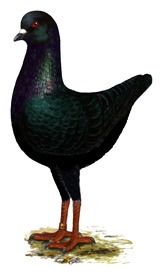 |
Black (-)
Highest demands must be placed to all major racial characteristics. Place great weight on satiated lacquer-rich color with much green gloss, and no deviation in the color of primaries. Further faults are too bright and too rough cere, loose neck plumage and split/swirl in plumage in cheek/neck area. In this stage of breeding have attention on straighten primaries. |
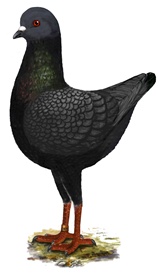 |
Andalusian (-)
High requirements can be placed at form, stand height and head points. The body color is blue-black, and somewhat bright appearing shield feathers. The shield feathers should be most broad and surrounded by a black lacing. Faults are uneven spotted shield, rust deposits, too light primaries and uneven lacing. |
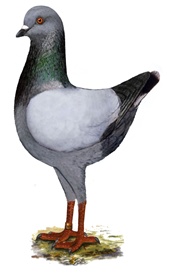 |
Blue Barless (-)
Observable are prima figures, tripartition and head points. The requirements in color are a pure pigeon-blue with most dark primaries. The 0.1 are sex-linked darker in body color. Too cloudy or approach of lacing on the shield is a fault. Pigeon with brownish primaries can no more reach sg (93 points). The unsightly split/swirl in plumage in cheek/neck area should downgrade in the judgment. Furthermore, have somewhat more attention of the size of figure and leg thickness. |
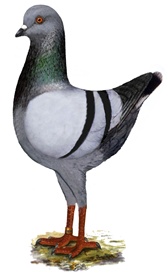 |
Blue with Black Bars (-) Like the Blue Barless highest demands of figure, stand height and head points can also be placed here. But here we need to keep the size “on eye”. In coloring there are hardly any complaints. Could partly in the bar guidance be more correctly - that bars should be well separated, drawn out, not jagged and pure (no rust deposits). |
 |
Blue Checker (-) Class of rounded figures and matching neck- and stand length are at hand. Points of “attack” are always to be found in the checkering image, either too open or too full / tight. The ideal checkering is achieved by two well-separated and sharply defined, not too large ovals in the upper part of the feather. The tip of the feather must be sufficient blue. The color of primary should be as dark as possible. Rust deposits must downgrade in the judgment. |
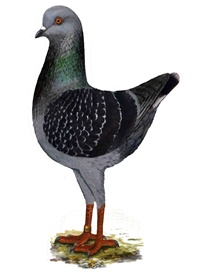 |
Blue Dark Checker (-)
New color impact, in which even the highest requirements on figure head points and stand length, can be placed. They show the dense form of checkering. Here the shield feather tip only has an arrow point or lacing. Consequently, too much body color (blue) in the shield is here a fault. |
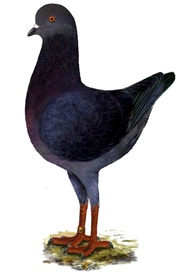 |
Dark (-)
Figurative they should catch up with the other checker. Only drawing color should appear on the shield and the shield color should therefore appear even dark. |
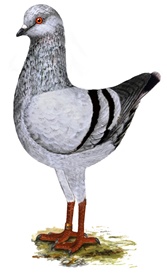 |
Blue Grizzle with Black Bars (-)
Show prima body fullness, stand height and head points. The mould should be evenly distributed over the entire body. The ideal mold color looks like a coating with frosty blue. In the neck feathers the basic part and the points of the feather are bright, the middle part is blue. Bars and tail bar are black. Primaries are as dark as possible. Faulty are bar rust, missing neck mould, large areas with white feathers, reeds in primaries visible from the outside. |
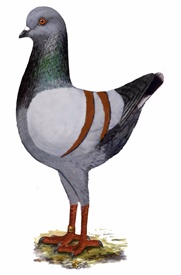 |
Blue with Bronze Bars (o)
Appealing in the form and stand height. There are still critical points to the head form and neck elegance. The bar color is the “eye catcher”. There are required a chestnut brown and pure color and shall at the end have a black lacing. Therefore too clayey bar color scales back to grade g (90 – 91 points). There is to be aimed for a smooth bar guidance. Look out for a dark and delicate eye cere. |
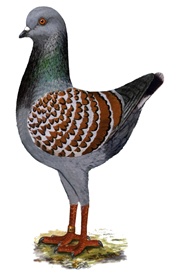 |
Bronze Tri (o)
Even with this Blue-bronze-checker there are rounded figures. The stand height, head rounding and neck nobility can be further improved. Wishes are naturally ever found in the shield drawing. The two chestnut-brown ovals on the feather must complete to the feather tip with a black seam. The feather end is light blue. If it is missing we get an erroneous for this color a laced impact, instead of the required checkering. Too clayey checker is to be rejected. |
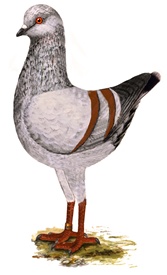 |
Blue Grizzle with Bronze Bars (o)
Figurative equated with the breeding partner Blue with Bronze Bars. In the mould drawing it is equal the Blue Grizzle with Black Bars . The bars are bronzed and close with a dark seam. Faulty are very impure bar- and breast color and too light primary color. |
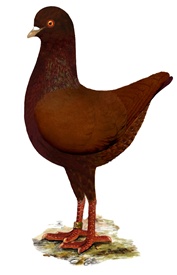 |
Red (-)
Round and broad body and rounded heads are available. In the necks they should be definitely more streamlined and elegant with flowing neck transition and demonstrate a firm neck plumage. We must demand a pure and rich red in which primary and tail color should not settle. The outer tail feathers should be maximized colored throughout. A blue wedge or tail color is not to be tolerated. The structure of the secondaries should be noted, because of the soft feather they easily tend to wear out. Be sure to pay attention to a pure beak and wattle color and also fine ceres. Oversized, coarse animals do not belong in the exhibitions. |
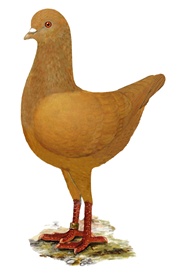 |
Yellow (-)
Prima short and round figures, appealing stand height and beautiful head points. What is desired is a bright even yellow color. Primary and tail color should not settle. Outer tail feathers colored through. In this color impact often problems to soft resp. hairy bar feathers, as well as the loose neck feather. There must be worked on a more intense eye color. Again, attention should be paid on the size as the neck nobility. |
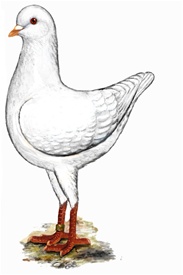 |
White (-)
Are prima in body rounding and stand height as well as in the heads. Still to take care of the neck nobility with fixed neck plumage. For an assessment of the sg it is essential of a colourful orange-red eye surrounded by a delicate, unobtrusive and bright cere. |
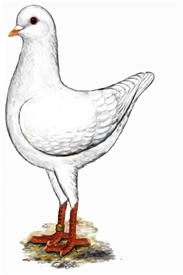 |
White with Dark Eyes and Red Cere (-)
Also in the 2nd variant of the white high demands can be provided on figure, stand height and head rounding. But should be shorter in the back. What is desired is an intensely red cere, which may not be too broad. A well “blood perfused” beak is special ornament. The upper limit of the size is partly achieved. Attention at the back cover. |
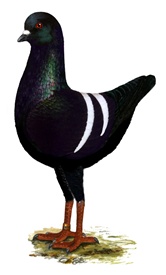 |
Black with White Bars (+)
Are present in a few breeds and quite good in stand height and neck length. Should however be shorter and rounder in the body and also more round in the heads. In color there are hardly any failures. There has yet to be worked on the bar guidance and separation. |
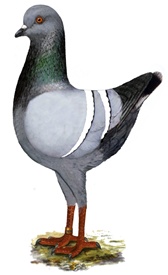 |
Blue with White Bars (+) Show quite good figures and body color. More stand height is desirable. Still to work on substance full heads, especially in the 0.1. The bars should be long and separated and must end with a black lacing. Pay attention on a smooth course of lacing; therefore ragged bars, as well as rust and strong peppery bars are undesirable. |
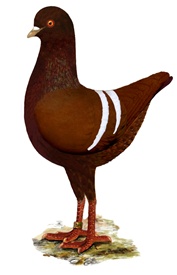 |
Red with White Bars (+)
A rare color impact. A matter of priority is to work at the main racial characteristics. That is more short body, round heads and matching stand height. In color they are not as intense as the red ones. The bars should be clearer. Problems are also to have a pure beak color. |
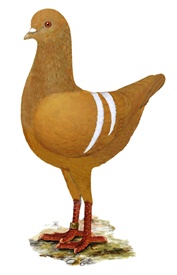 |
Yellow with White Bars (+)
Similarly, the foregoing also applies to the Yellow with White Bars. They could be even tighter in the plumage. Also the beak length should be noted. |
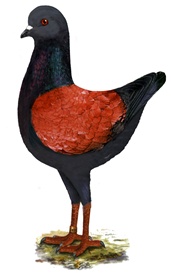 |
Bronze Clear (o)
Show pretty stylish figures, good head form and great eye color. Body and color of primaries should be as dark as possible. Incorrect therefore is too blue belly or thigh color. Bronze deposits in primary are color reserves, finch drawing is regarded as special ornament, and limited color deposits in the flanks are to be tolerated. The shield color must be fawn brown and must not be too bright. Furthermore, the shield must be pure, that is, without approach of lacing. Add weight on fixed bar feathers. |
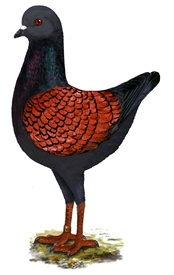 |
Bronze Laced (o) They show quite good breast width and rounding, but should still be shorter in the back. Also still work to do at stand height and neck nobility. Look out for a dark body color, also in the belly and thigh. The shield color is chestnut brown and must not be too light or clayey. Have attention on broad shield feathers surrounded of a dark lacing. A blue lacing at the tip of the shield feathers is a fault. |
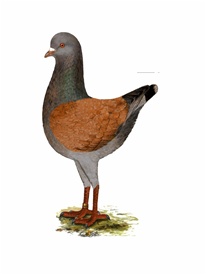 |
Sulphur Clear (+)
Very rare color impact should be evaluated indulgently. In addition to the main racial characteristics these rarities are still “struggling” with purer breast and shield color. The body is greyish blue; the primaries are inside yellowish and phasing dark out. The target is a light yellow shield color, pure as possible. |
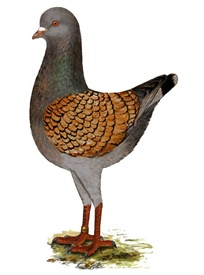 |
Sulphur Laced (+) Also rarely shown color impact. Should also be evaluated indulgently. The body color is greyish blue, the primaries are inside yellowish and phasing dark out. Not too exaggerated demands should be made at the lacing. |
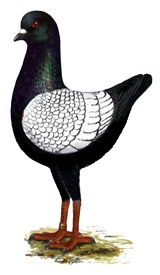 |
Black Argent (+)
Rarely shown color impact with some breeding difficulties. They also show quite good figures. Breeding focus should lie on more head rounding and shorter beaks. Lacquer black body color is available. To work for more pure white shield color with an enclosing lacing. Brightened outer tail feather or visible tail bar are faulty. |
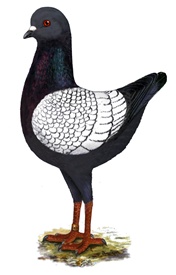 |
Dark Argent (+)
Have the most widely prevalence among the white shielded and show very good figures. The upper head rounding, beak length and graded neck finish should be improved. The body color is required dark (blue-black), including legs and flanks. The tail feathers are bluish with distinct tail bar. The shield color so white as possible, not too creamy and free of pepper or rust. Most attention on a broad shield feather surrounded of a dark lacing. |
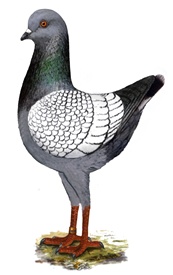 |
Blue Argent (+) Quite good in stand height and body posture. There is still room for improvement in corpulence and head rounding. A possible clear, but not too bright blue color from head to tail is desirable. The tail shows a tail bar. Have attention for pure flanks without shades. The shield color should be pure, the encircling lacing as dark as possible. Rust or pepper is faulty. |
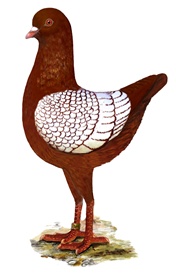 |
Red Argent (+)
Shows a pretty good figure and stand height, but should yet increase in the length of neck and head points. To look out for a pure beak color - in an intense color, a lighter approach can be tolerated. A desire to a pure and intense body color from head to tail, the primaries should show most of coloring. The shield color should be more pure with a correcter lacing. |
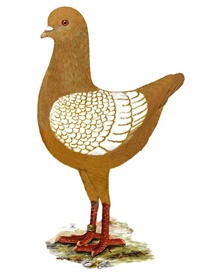 |
Yellow Argent (+) Also, as the foregoing a small collection is available. There has to be worked on a more shortly body with more width, stand height and neck length. We should pay attention on lively irises. The body color should be full colored. The primaries have to show coloring. It requires a pure light shield color. The eponymous lacing should be clearer. |
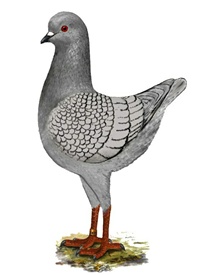 |
Light Gray Argent (o)
Approved in 2010, but this color impact has not quite taken hold. But i.a. through the connection to the Black Schietti corresponding demands is made on the form and stand height. They have a light gray body color; head and upper neck are darker. Shield and primaries are with dark lacing. |
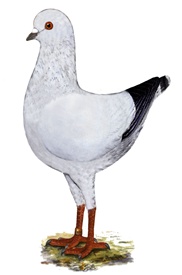 |
Icecolored Barless (+)
The ice color is quite well. The tail bar should be black, separated and clear. But there is still much room for improvement in type, stand height and body. The heads must be more racial topic. |
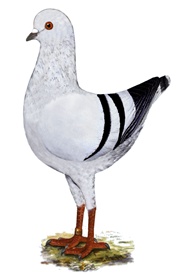 |
Icecolored with Black Bars (+)
As aforementioned good in the ice color. The bars are black, tail bar black and clear delineated. The heads and beaks have to be more typically. Because of the years after the approval they should not so clearly show the in crossing of Damascener and Ice Colored Italian Owl. To obtain required three-points partition they have to be improved in stand height and shortness of body. Approach of jabot and dewlaps can not be tolerated.
Faulty: Missing stand height, insufficient body depth, too long neck, angular head. |
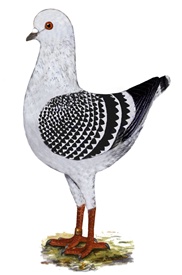 |
Icecolored Checker (+)
Advantages and faults as aforementioned. Take attention at a regular black checkering….. |
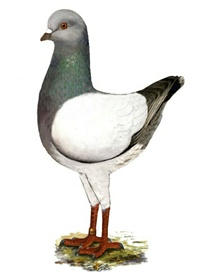 |
Silver Barless (o)
Good in stand height, length of neck and head points, so nevertheless this attractive color impact should find more widespread. In type there should be worked on more elegance and charisma. Further more the necks should be slimmer. In color an evenly, bright and delicate blue silver is desired. The color of the primaries and tail should not be too bright, and should be rich as possible. The tail has a dark bar. Ochre color at breast is a fault. |
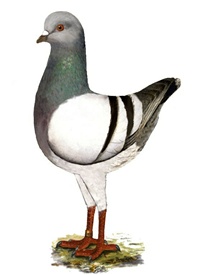 |
Silver with Dark Bars (o)
Good figures, matching stand height and neck length are present. Also, they should be more elegant in type. With respect to color the same applies as at the foregoing. Attention must be paid to dark bars without rust deposits. |
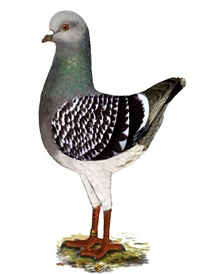 |
Silver Checker (o)
Figurative and color, they are quite well positioned, but are occasionally seen in coarse types. Of great importance is an evenly checker design, not too full and not too open, and without rust deposits. |
 |
Silver Dark Checker (o)
Newly added color impact, has not yet been shown on the main special exhibitions. Figurative and color the same applies as for the Silver Checker. The body color should be ousted on the shield so far that only an arrow point drawing or even a form of lacing can be seen. Everything else can not be valid as dark checker. |
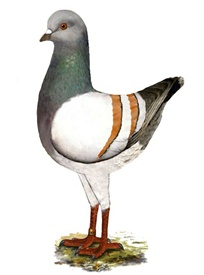 |
Silver with Sulphur Bars (+)
Very rarely shown color impact, should therefore be assessed indulgently. Yet pretty good figures already exist. In color analogous to the foregoing they should show ochre bars that have a dark lacing. The chest color will not be as pure to achieve as in the other blue pale ones. |
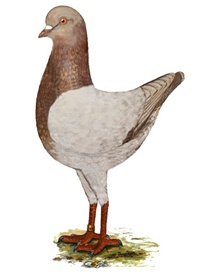 |
Russet Clear (o)
The barless variant of Russet is quite rare to see. There should be been working towards more elegant types with matching stand height and slim, smooth neck. The shield should show a bright evenly gray-brown. Head, tail and wedge are darker; with tail bar. Primaries as possible gray brown colored. The eye color should not brighten too much up. |
 |
Russet with Bronze Bars (o)
Occurrence in small collections. They should as the foregoing be more elegant. An evenly shield color should be required. The bar color should be reddish brown and finish with a dark brown lacing. The tail bar must be clearly delineated. The orange-red eye color should also be wanted here. |
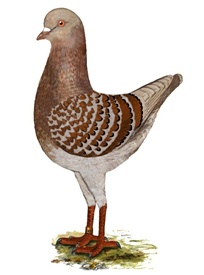 |
Russet - Tri (o)
Like their barred relatives they are found in rather small collections. Also here needs to be worked on more stand height and neck nobility. In terms of color the same applies as with the foregoing. The color of the checker is reddish brown with enclosed dark brown lacing. To provide space to a sufficient drawing it’s placing emphasis on broad shield feather. |
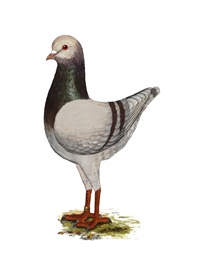 |
Russet with Brown Bars (-)
Newly approved color impact (2013), however, existed for some time as a breeding partner of Russet Dun Grizzle with Brown Bars. They show prima short and rounded figures. The heads are very good. In terms of color they are desired as the bronze barred variant. They differ only in the bar color; this is required brown and without lacing. |
 |
Russet Dun Grizzle with Brown Bars (-)
Show prima short bodies, heads and matching stand height. Based on Russet with Brown Bars they should have an evenly moldiness all over the body. The primaries and tail feathers may not brighten up as the Ash Red Grizzle. Have attention on a pure bar color absolutely without any form of lacing. |
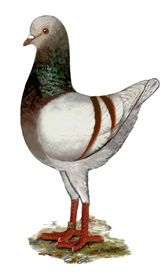 |
Mealy with Red Bars (-)
This color impact is represented in strong collections and they fascinate with short forms, good standing height and attractive head points. Further on there must be worked on a pure shield color, and may not act too loamy. Head and bar color should match. Too bright head color is therefore a fault, as too blue head or shield color. Have attention on color reserves in the insides of the primaries. Faulty are furthermore different color splashes/stipper in tail and wings. |
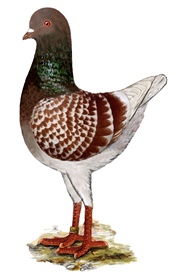 |
Red Checker (-) High demands can be placed at type, figure and stand height. In color they are slightly more intense than the Mealy with Red Bars. The approval of Red Dark Checker results, that the demands on the checker distribution must be more heavily weighted. It should be regularly with contrast and not too full. Too much shade of blue in the color is a fault. Other errors are a different color splashes/stipper in tail and primaries. |
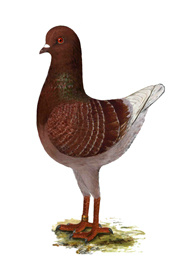 |
Red Dark Checker (-)
New color impact, figuratively, the same requirements to provide as with Red Checker. They should also show the dense form of checkering and only the sign of arrow pointed drawing or presence of laced drawing on the shield. Fault as aforementioned. |
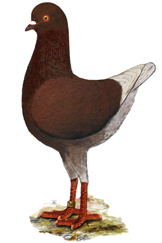 |
Dominant Red (-)
New color impact, figuratively equate the two foregoing. Focus here is on the shield. Only drawing color should be recognizable. Any brightening or lacing is unwanted. Primaries and tail are brightened. Faulty are differently colored splashes/stipper in tail and primary. |
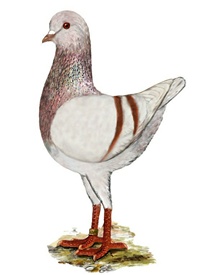 |
Ash Red Grizzle with Red Bars (-) Figurative they are attractive, even in the head points. An evenly grizzle drawing over the body must be required. Head, neck and bars are intense red coated with mold. Primary and tail feathers act by the mold almost white. |
 |
Cream with Yellow Bars (-) In form very good animals but should be more elegant in the neck form and more firm in the plumage. If possible - an evenly, delicate yellow body color, - the head, neck and bar- color are more intense yellow. Primaries and tail including wedge are cream white, which is to ensure that the wedge still shows enough coloring. Therefore, pure white primaries and tail feathers are faulty. For 1.0, the head color has not to brighten too much. In the 0.1, however, the blue color (in cheek area) should disappear. The beak may not be too dark. Different color splashes/stipper in tail and primary are faulty. |
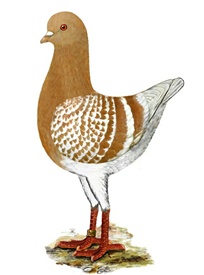 |
Yellow Checker (-)
Quite good in figure and heads. Neck nobility and the firmness of plumage are to be improved. Pay attention to an evenly, high-contrast checkering (not too full) and for broad shield feathers. In color they are more intense yellow than the Cream with Yellow Bars. Faulty are differently colored splashes/stipper in tail and primaries. |
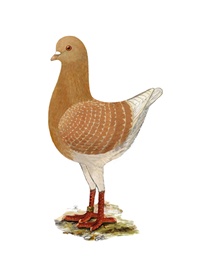 |
Yellow Dark Checker (-)
Figurative as fore mentioned with the dark form of checkering. Fault as fore mentioned. |
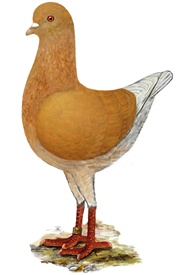 |
Dominant Yellow (-)
Similar to the Dominant Red this new color impact should show an evenly colored shield without brightening. Figurative the goal is the expectations of the Yellow Checker. Faulty are differently colored splashes/stipper in tail and primary. |
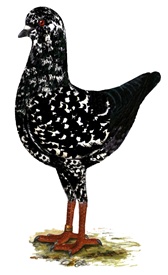 |
Black Teager (-)
High demands can be made on figure, standing height and head points. With an intense black body color the white teager drawing should be evenly distributed over the entire body. In any event breast and shields should be drawn. Tail and primaries must be black. Therefore it is a fault if there are white feathers in tail or primaries/secondary’s, as well as reed, too little teager drawing, red or rough eye ceres. Pay attention to the purity of color. |
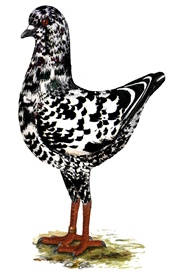 |
Black Mottle (-)
Like the Black Teager, but with white feathers in primaries and tail. Per missing white feather in primaries/tail it results in a deduction of one point. In color it appears brighter than the Black Teager. With increasing age, they become brighter, however large monochrome feather areas are not wanted here. Again, pay attention to color purity, i.e. the primaries/tail feathers should be either white or black; – points must be deducted when feathers here are two-colored. |
 |
Blue Teager (-)
Shows an appealing figure and posture. Should be more elegant in the neck, i.e. more stretched and slim. The body color is a pure blue, with no approach of bar, and with an evenly distributed teager drawing all over the entire body. Somewhat carbon (pepper) storages in the bar area has to be tolerated. |
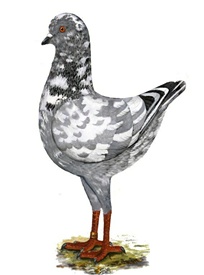 |
Blue Mottle (-)
Figurative like Blue Teager. The main impression of the drawing image is clean blue feathers regularly as possible distributed in a white body color. As much as possible also mottled in primaries and tail. Mottle formed by blue colored flecks/splashes in the feathers is faulty. |






